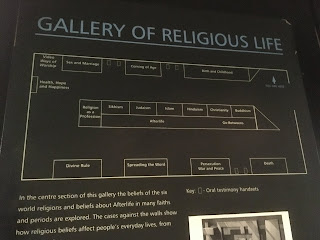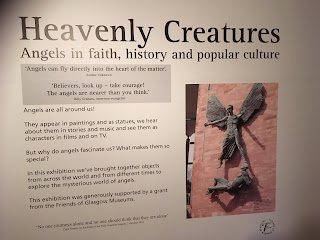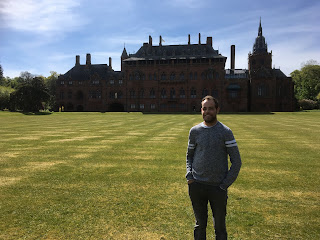Ardgowan House is a 18th century mansion which is privately owned by Sir Ludovic 'Ludo' Shaw Stewart, who inherited it from his father when he was 17 years old.
He talk us on a tour of the house and informed us of its history, and also the history of the Stewart family. Since the 15th century, the Ardgowan estate has been held by the Stewart family.
Ludo informed us of some discoveries that have been found - one is a pair of 18th century shoes found under the house which are now on display. Another is a Bronze Age axe head which he showed us and passed it around. The axe head was discovered under the ground in the field in front of the house, and indicates that the area has been inhabited for 4000 years. Also a Roman silver coin was found in the fields. The name Ardgowan means 'Hill of the smith' in Gaelic.
He gave us a history of Robert the Bruce, and the history of Inverkip Castle of which there are remains on the estate. The Stewart family is descended from Robert the Bruce's great grandson, Robert the 3rd.
The first stone of the house was laid in 1798 and building was completed in 1801. There is a certain mystery around the construction of the house, and the reasons why it was built by Sir John Shaw Stewart. He had no children so the house was passed onto his nephew Sir Michael. With 76 rooms, it was built in the style of Robert Adam, the neoclassical architect.
Sir Michael made some changes to the house - he removed the external staircase which lead up to the Library (which used to be the Front Hall) so originally the entrance to the house was up these outside stairs. The Chapel was added in the 19th century, and during WWI and WWII the house was used as a hospital (similar to Mount Stuart).
The house was recently used for the filming of Agatha Christie's Ordeal by Innocence, the mini series that was released last year. Here is an interesting article about the filming:
As mentioned in the article, Sir Ludo told us of the ordeal of having the crew, 160 people, living in the house for 6 months. It was originally filmed in the summer of 2017, but then last year they had to reshoot it with Ed Westwick's part recast because the actor was accused of sexual assault. So the scenes had to be reshot in the winter of 2018.
Sir Ludo showed us a key that he found in an auction, designed by Charles Rennie Mackintosh for the Glasgow School of Art. A couple of months after he bought the key, the Glasgow School of Art suffered a fire (for the second time) which meant most of the items didn't survive.
He also showed us some of the archives - letters of correspondence which are in boxes currently stored away in the Library.
After the tour and morning tea in the Drawing Room, the bus dropped some of us off at the airport to head home.
































































